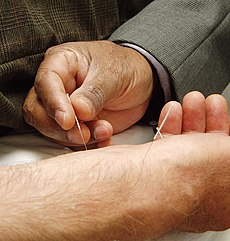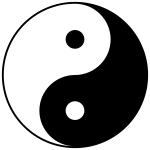针灸:修订间差异
Great Brightstar(留言 | 贡献) 小无编辑摘要 |
Great Brightstar(留言 | 贡献) 小无编辑摘要 |
||
| 第11行: | 第11行: | ||
}} |
}} |
||
{{替代医学}} |
{{替代医学}} |
||
'''針灸'''<ref>{{標音|拼音=zhēn jiǔ |注音= ㄓㄣ ㄐ一ㄡˇ}},英文拼作{{lang|en|Acupuncture and moxibusion}}</ref>是在[[中醫學]]中採用[[針]]刺或火[[灸]]人體[[穴位]]來治療[[疾病]]的方法,是[[联合国教科文组织]]认定的[[人类非物质文化遗产代表作]]之一。根据中医学理论,通过刺激穴位可以改善[[经络]]中的气的流向<ref name="NIH-1997consensus">{{cite web |author=NIH Consensus Development Program |title=Acupuncture --Consensus Development Conference Statement |url=http://consensus.nih.gov/1997/1997Acupuncture107html.htm |date=3–5 November 1997 |publisher=[[National Institutes of Health]] |accessdate=2007-07-17| archiveurl= http://web.archive.org/web/20070714081037/http://consensus.nih.gov/1997/1997Acupuncture107html.htm| archivedate= 14 July 2007 <!--DASHBot-->| deadurl= no}}</ref>。现代科学从[[组织学]]和[[生理学]]上尚未发现气、经络或者穴位的存在<ref name = SinghErnstTCM>{{cite book | last = Singh | first = S | authorlink = Simon Singh | coauthors = [[Edzard Ernst|Ernst E]] | year = 2008 | title = [[Trick or Treatment|Trick or treatment: The undeniable facts about alternative medicine]] | isbn = 978-0-393-06661-6 | publisher = [[W. W. Norton & Company]] | pages = 39–90 | chapter = The Truth about Acupuncture | quote="Scientists are still unable to find a shred of evidence to support the existence of meridians or Ch'i" (p72 – UK Ed.), "The traditional principles of acupuncture are deeply flawed, as there is no evidence at all to demonstrate the existence of Ch'i or meridians" (p107 – UK Ed.) "Acupuncture points and meridians are not a reality, but merely the product of an ancient Chinese philosophy" (p387 – UK Ed.)}}</ref><ref name = Bauer>{{cite journal |first=M |last=Bauer |url=http://www.chinesemedicinetimes.com/section.php?xSec=122 |journal=Chinese Medicine Times |volume=1 |issue=4 |page=31 |year=2006 |title=The Final Days of Traditional Beliefs? – Part One}}</ref><ref name="Ahn2008" />,且部分当代针灸使用者并非依据传统理论体系进行实践<ref name=Mann>{{cite book | last = Mann | first = F | authorlink = Felix Mann | isbn = 0-7506-4857-0 | publisher = [[Elsevier Health Sciences|Elsevier]] | year = 2000 | title = Reinventing acupuncture: a new concept of ancient medicine}}</ref><ref name="Peñas2010">{{cite book |last1=de las Peñas |first1=César Fernández |last2=Arendt-Nielsen |first2=Lars |last3=Gerwin |first3=Robert D |title=Tension-type and cervicogenic headache: pathophysiology, diagnosis, and management |publisher=[[Jones & Bartlett Learning]] |year =2010 |isbn=978-0-7637-5283-5 | pages = [http://books.google.ca/books?id=HpRwMB-cNCoC&pg=PA251#v=onepage&q&f=false 251–4] }}</ref>。 |
'''針灸'''<ref>{{標音|拼音=zhēn jiǔ |注音= ㄓㄣ ㄐ一ㄡˇ}},英文拼作{{lang|en|Acupuncture and moxibusion}}</ref>是在[[中醫學]]中採用[[針]]刺或火[[灸]]人體[[穴位]]來治療[[疾病]]的方法,是[[联合国教科文组织]]认定的[[人类非物质文化遗产代表作]]之一。根据中医学理论,通过刺激穴位可以改善[[经络]]中的气的流向<ref name="NIH-1997consensus">{{cite web |author=NIH Consensus Development Program |title=Acupuncture --Consensus Development Conference Statement |url=http://consensus.nih.gov/1997/1997Acupuncture107html.htm |date=3–5 November 1997 |publisher=[[National Institutes of Health]] |accessdate=2007-07-17| archiveurl= http://web.archive.org/web/20070714081037/http://consensus.nih.gov/1997/1997Acupuncture107html.htm| archivedate= 14 July 2007 <!--DASHBot-->| deadurl= no}}</ref>。现代科学从[[组织学]]和[[生理学]]上尚未发现气、经络或者穴位的存在<ref name = SinghErnstTCM>{{cite book | last = Singh | first = S | authorlink = Simon Singh | coauthors = [[Edzard Ernst|Ernst E]] | year = 2008 | title = [[Trick or Treatment|Trick or treatment: The undeniable facts about alternative medicine]] | isbn = 978-0-393-06661-6 | publisher = [[W. W. Norton & Company]] | pages = 39–90 | chapter = The Truth about Acupuncture | quote="Scientists are still unable to find a shred of evidence to support the existence of meridians or Ch'i" (p72 – UK Ed.), "The traditional principles of acupuncture are deeply flawed, as there is no evidence at all to demonstrate the existence of Ch'i or meridians" (p107 – UK Ed.) "Acupuncture points and meridians are not a reality, but merely the product of an ancient Chinese philosophy" (p387 – UK Ed.)}}</ref><ref name = Bauer>{{cite journal |first=M |last=Bauer |url=http://www.chinesemedicinetimes.com/section.php?xSec=122 |journal=Chinese Medicine Times |volume=1 |issue=4 |page=31 |year=2006 |title=The Final Days of Traditional Beliefs? – Part One}}</ref><ref name="Ahn2008">{{cite journal |last1=Ahn |first1=Andrew C. |last2=Colbert |first2=Agatha P. |last3=Anderson |first3=Belinda J. |last4=Martinsen |first4=ØRjan G. |last5=Hammerschlag |first5=Richard |last6=Cina |first6=Steve |last7=Wayne |first7=Peter M. |last8=Langevin |first8=Helene M. |title=Electrical properties of acupuncture points and meridians: A systematic review |journal=Bioelectromagnetics |volume=29 |issue=4 |pages=245–56 |year=2008 |pmid=18240287 |doi=10.1002/bem.20403 |url=https://mn.uio.no/fysikk/english/research/projects/bioimpedance/publications/papers/meridian_rev.pdf}}</ref>,且部分当代针灸使用者并非依据传统理论体系进行实践<ref name=Mann>{{cite book | last = Mann | first = F | authorlink = Felix Mann | isbn = 0-7506-4857-0 | publisher = [[Elsevier Health Sciences|Elsevier]] | year = 2000 | title = Reinventing acupuncture: a new concept of ancient medicine}}</ref><ref name="Peñas2010">{{cite book |last1=de las Peñas |first1=César Fernández |last2=Arendt-Nielsen |first2=Lars |last3=Gerwin |first3=Robert D |title=Tension-type and cervicogenic headache: pathophysiology, diagnosis, and management |publisher=[[Jones & Bartlett Learning]] |year =2010 |isbn=978-0-7637-5283-5 | pages = [http://books.google.ca/books?id=HpRwMB-cNCoC&pg=PA251#v=onepage&q&f=false 251–4] }}</ref>。 |
||
当代科学研究支持针灸可以缓解疼痛与术后恶心的效用<ref name="pmid15266478"/><ref name="pmid21440191"/><ref>http://www.cancer.gov/cancertopics/pdq/cam/acupuncture/patient/Page2#Section_53</ref>。有人质疑针灸的效用极其微弱不足以建立临床关系,并且可能是[[双盲]]实验不适当的结果<ref name = Madsen2009>{{cite journal |last1=Madsen |first1=M. V. |last2=Gotzsche |first2=P. C |last3=Hrobjartsson |first3=A. |title=Acupuncture treatment for pain: systematic review of randomised clinical trials with acupuncture, placebo acupuncture, and no acupuncture groups |journal=BMJ |volume=338 |pages=a3115 |year=2009 |pmid=19174438 |pmc=2769056 |doi=10.1136/bmj.a3115}}</ref>,亦或可用[[安慰剂]]效应<ref name = "Ernst2006">{{cite pmid | 16420542 }}</ref><ref name = RetractingNeedleStudies>{{cite book | last = Singh | first = S | authorlink = Simon Singh | coauthors = [[Edzard Ernst|Ernst E]] | year = 2008 | title = [[Trick or Treatment|Trick or treatment: The undeniable facts about alternative medicine]] | isbn = 978-0-393-06661-6 | publisher = [[W. W. Norton & Company]] | pages = 103–106 | chapter = The Truth about Acupuncture | quote="These initial conclusions have generally been disappointing for acupuncturists: They provide no convincing evidence that real acupuncture is significantly more effective than placebo." (p. 104)}}</ref>或[[发表偏倚]]来解释<ref name=Lee2006/><ref name=Tang1999 |
当代科学研究支持针灸可以缓解疼痛与术后恶心的效用<ref name="pmid15266478">{{cite journal |author=Lee A, Fan, LTY |editor1-last=Lee |editor1-first=Anna |title=Stimulation of the wrist acupuncture point P6 for preventing postoperative nausea and vomiting |journal=Cochrane Database of Systematic Reviews (Online) |issue=2 |pages=CD003281 |year=2009 |pmid=15266478 |doi=10.1002/14651858.CD003281.pub3 |url=http://www.cochrane.org/reviews/en/ab003281.html}}</ref><ref name="pmid21440191">{{cite pmid|21440191 }}</ref><ref>http://www.cancer.gov/cancertopics/pdq/cam/acupuncture/patient/Page2#Section_53</ref>。有人质疑针灸的效用极其微弱不足以建立临床关系,并且可能是[[双盲]]实验不适当的结果<ref name = Madsen2009>{{cite journal |last1=Madsen |first1=M. V. |last2=Gotzsche |first2=P. C |last3=Hrobjartsson |first3=A. |title=Acupuncture treatment for pain: systematic review of randomised clinical trials with acupuncture, placebo acupuncture, and no acupuncture groups |journal=BMJ |volume=338 |pages=a3115 |year=2009 |pmid=19174438 |pmc=2769056 |doi=10.1136/bmj.a3115}}</ref>,亦或可用[[安慰剂]]效应<ref name = "Ernst2006">{{cite pmid | 16420542 }}</ref><ref name = RetractingNeedleStudies>{{cite book | last = Singh | first = S | authorlink = Simon Singh | coauthors = [[Edzard Ernst|Ernst E]] | year = 2008 | title = [[Trick or Treatment|Trick or treatment: The undeniable facts about alternative medicine]] | isbn = 978-0-393-06661-6 | publisher = [[W. W. Norton & Company]] | pages = 103–106 | chapter = The Truth about Acupuncture | quote="These initial conclusions have generally been disappointing for acupuncturists: They provide no convincing evidence that real acupuncture is significantly more effective than placebo." (p. 104)}}</ref>或[[发表偏倚]]来解释<ref name=Lee2006>{{cite journal |author=Lee A, Copas JB, Henmi M, Gin T, Chung RC |title=Publication bias affected the estimate of postoperative nausea in an acupoint stimulation systematic review |journal=J Clin Epidemiol. |volume=59 |issue=9 |pages=980–3 |year=2006 |pmid=16895822|doi=10.1016/j.jclinepi.2006.02.003 }}</ref><ref name=Tang1999>{{cite journal |last1=Tang |first1=JL |last2=Zhan |first2=SY |last3=Ernst |first3=E |title=Review of randomised controlled trials of traditional Chinese medicine |journal=BMJ (Clinical research ed.) |volume=319 |issue=7203 |pages=160–1 |year=1999 |pmid=10406751 |pmc=28166 |doi=10.1136/bmj.319.7203.160}}</ref>。 |
||
== 治療方法 == |
== 治療方法 == |
||
| 第27行: | 第27行: | ||
相传[[伏羲氏]]创[[九针]]。为九种针具的总称。出《[[黄帝内经]]》。即鑱针、员针、鍉针、锋针、铍针、员利针、毫针、长针和大针。《灵枢·官针》:“九针之宜,各有所为;长短大小,各有所施也,不得其用,病弗能移。”指出九针的形状、用途各异,据情选用,方可去病。 |
相传[[伏羲氏]]创[[九针]]。为九种针具的总称。出《[[黄帝内经]]》。即鑱针、员针、鍉针、锋针、铍针、员利针、毫针、长针和大针。《灵枢·官针》:“九针之宜,各有所为;长短大小,各有所施也,不得其用,病弗能移。”指出九针的形状、用途各异,据情选用,方可去病。 |
||
{{-}} |
|||
== 历史 == |
== 历史 == |
||
{{中醫學}} |
{{中醫學}} |
||
2012年11月28日 (三) 14:04的版本
| 針灸 | |
|---|---|
 針灸 | |
| ICD-10-PCS | 8E0H30Z |
| ICD-9 | 99.91-99.92 |
| MeSH | D015670 |
| OPS-301 | 8-975.2 |
| 替代医学和伪医学 |
|---|
 |
針灸[1]是在中醫學中採用針刺或火灸人體穴位來治療疾病的方法,是联合国教科文组织认定的人类非物质文化遗产代表作之一。根据中医学理论,通过刺激穴位可以改善经络中的气的流向[2]。现代科学从组织学和生理学上尚未发现气、经络或者穴位的存在[3][4][5],且部分当代针灸使用者并非依据传统理论体系进行实践[6][7]。
当代科学研究支持针灸可以缓解疼痛与术后恶心的效用[8][9][10]。有人质疑针灸的效用极其微弱不足以建立临床关系,并且可能是双盲实验不适当的结果[11],亦或可用安慰剂效应[12][13]或发表偏倚来解释[14][15]。
治療方法
針與灸是治療方法的兩個方面,多用針法來治療急性病,用灸法來治療慢性病。中医学中針灸治療的理論基礎在於傳統的中醫臟腑陰陽經絡學說。和中醫的方劑治療方法相比較,針灸治療的特點是療效快[來源請求]、簡單、便宜。
中醫施針的穴位,按深度分為天、人、地三層,當針灸到達每一層時,均有「針感」,患者會感到酸、脹、麻,而施術的醫生則有粘針的感覺。進行針灸時,醫生會按不同需要,施針在不同深度,以進行合適的治療。
针灸灸疗法包括针刺和灸灼两种不同的治疗方法。针刺法也称针治法,是运用一定的操作手法,把金属制成的、形体细长而尖的针刺入人体的某一固定的部位(穴位),使接受针刺才发生酸、麻、胀、重等感觉,从而产生治疗疾病的作用。灸灼法也称为灸治法,是将艾绒揉成小团或长条状,点燃后放在(或靠近)人体体表的某些固定的部位,施行热熨或熏,从现时达到治疗疾病的目的。
针具
針由遠古時代的骨針、石砭開始發展到長短、大小、式樣、材料、方法各不相同的針具,如電針、磁針、水針等;灸偏向於傳統的艾灸,有艾絨灸、艾條灸等,現代醫學中採用紅外線照射也有類似作用。现代使用的针灸多是钢针,而在古代多使用的是银针,其功效要比钢针好[來源請求]。
相传伏羲氏创九针。为九种针具的总称。出《黄帝内经》。即鑱针、员针、鍉针、锋针、铍针、员利针、毫针、长针和大针。《灵枢·官针》:“九针之宜,各有所为;长短大小,各有所施也,不得其用,病弗能移。”指出九针的形状、用途各异,据情选用,方可去病。
历史
| 系列条目 |
| 中医学 |
|---|
 |
针灸起源于中国,具有悠久的历史。针刺法萌发于新石器时代。当人们发生某些病痛或不适的时候,不自觉地用手按摩、捶拍,以至用尖锐的石器按压疼痛不适的部位,而使原有的症状减轻或消失,最早的针具:砭石也因之而生。随着古人智慧和社会生产力的不断发展,针具逐渐发展成青铜针、铁针、金针、银针,直到现在用的不锈钢针。相传,华夏文明的始祖伏羲是中医针灸的发明人。伏羲氏不仅画八卦,结绳为网,教民田猎,而且“尝百药而制九针”(东汉皇甫谧记载于《帝王世纪》)、“尝草制砭”(南宋罗泌记载于《路史》)。砭就是砭石,即华夏民族最早的针灸。灸法的起源与为的发现和使用有着密切的关系,当身体有某种不适时,用以去烘烤得以减轻,继而用各种树枝作为施灸工具,逐渐发展到艾灸。
针灸治疗方法是在漫长的历史过程中形成的,其学术思想也随着临床医学经验的积累渐渐完善。1973年长沙马王堆三号墓出土的医学帛书中有《足臂十一脉灸经》和《阴阳十一脉灸经》,论述了十一条脉的循行分布、病候表现和灸法治疗等,已形成了完整的经络系统。《黄帝内经》是现存的中医文献中最早而且完整的中医经典著作,已经形成了完整的经络系统,即有十二经脉、十五络脉、十二经筋、十二经别以及与经脉系统相关的标本、根结、气街、四海等,并对腧穴、针灸方法、针刺适应症和禁忌症等也做了详细的论述。尤其是《灵枢经》所记载的针灸理论更为丰富而系统,所以《灵枢》是针灸学术的第一次总结,其主要内容至今仍是针灸的核心内容,故《灵枢》称为《针经》。继《内经》之后,战国时代的神医扁鹊所著《难经》对针灸学说进行了补充和完善。
晋代医学家皇甫谧潜心钻研《内经》等著作,撰写成《针灸甲乙经》,书中全面论述了脏腑经络学说,发展并确定了349个穴位,并对其位置、主治、操作进行了论述,同时介绍了针灸方法及常见病的治疗,是针灸学术的第二次总结。
唐宋时期,随着经济文化的繁荣昌盛,针灸学术也有很大的发展,唐代医学家孙思邈在其著作《备急千金要方》中绘制了彩色的"明堂三人图",并提出阿是穴的取法及应用。到了宋代,著名针灸学家王惟一编撰了《铜人腧穴针灸图经》,考证了354个腧穴,并将全书刻于石碑上供学习者参抄拓印,他还铸造了2具铜人模型,外刻经络腧穴,内置脏腑,作为针灸教学的直观教具和考核针灸医生之用,促进了针灸学术的发展。
元代滑伯仁所者的《十四经发挥》,首次将十二经脉与任、督二脉合称为十四经脉,对后人研究经脉很有裨益。
明代是针灸学术发展的鼎盛时期,名医辈出,针灸理论研究逐渐深化,也出现了大量的针灸专著,如《针灸大全》、《针灸聚英》、《针灸四书》,特别是杨继洲所著的《针灸大成》,汇集了明以前的针灸著作,总结了临床经验,内容丰富,是后世学习针灸的重要参考书,是针灸学术的第三次总结。
清初至民国时期,虽然针灸医学由兴盛逐渐走向衰退,但由于针灸深得民心,故仍有《针灸逢源》等著作流传下来。
中华人民共和国成立50年以来,以继承为基础,结合现代医家的临床经验和科研成果,出版了大量的针灸学术专著和论文,还成立了中国针灸学会,学术交流十分活跃,首创"针刺麻醉"。针灸的研究也从单一的文献整理发展到对其治病的临床疗效进行系统的观察,结合现代生理学、解剖学、组织学、生化学、免疫学、分子生物学等学科进行针灸治疗的机理探讨,取得了可喜的成就。
针灸学虽源于中国,但早在公元6世纪就传到了朝鲜、日本等国。近年来,随着中外文化交流的不断深入,针灸也随之传到世界各地。为了加速针灸医学的广泛传播,在中国北京、上海、南京设立了三大国际针灸培训中心,以培养世界各地的针灸人才。1987年成立了世界针灸学会联合会(简称"世界针联"),推动了针灸事业的不断发展。

原理
人體中的經絡系統負責輸送全身的「氣」、「血」及「血液」,這些輸送物質在體內循環,使身體中的各個組織與器官保持平衡與穩定。然而當經絡系統出現阻塞不通的情況時,則影響了這些物質的輸送,使「邪氣」(各種產生病變的因子)侵入,此時人體就會開始出現異常病變。當針灸的針插進人體之後,會引起人體自身的反應,加強氣血循環,克服經絡的阻塞,使經絡系統恢復正常,病症因此得以治癒。
美国纽约州罗彻斯特大学医学中心的神经科学家Maiken Nedergaard利用小鼠进行的试验发现,针刺入组织后释放了大量的腺苷,帮助抑制疼痛,此研究有助于消除對針灸的質疑。[16]
對針灸的質疑
對於針灸的質疑,主要是因為針灸的理論基礎源於中醫學,與現代醫學的思維模式相距甚大。中國科學界對於針灸的研究已經有半個世紀,特別是針刺麻醉或者針刺止痛原理的研究,居於世界前列。
世界衛生組織(WHO)在1979年所出版的刊物中認可針灸在某些症狀中有治療作用[17]。Cochrane Collaboration的科學家認為針灸對戒煙、氣喘、抗類風濕關節炎、頭疼等問題沒有效用。2007年9月《內醫檔案》雜誌刊登,德國雷根斯堡大學的邁克爾·哈克博士主持的實驗使用1162名腰痛病患分3組分別進行針灸、假針灸和常規治療對比試驗。發現腰痛情況好轉的人,針灸組有47.6%,假針灸組有44.2%,常規治療組有27.4%。針灸組和假針灸組沒有統計學意義的差別。[18][19]2009年西雅图的一个研究小组主持的研究表明,对长期腰疼患者,针灸和假针的治疗效果都比传统方法好,但是针灸和假针的疗效没有显著差异。[20]
世界衛生組織在2003年發表了《Acupuncture: Review and Analysis of Reports on Controlled Clinical Trials》,認為有對照試驗證實針灸可有效治療若干疾病、症狀或狀態,針灸對於另外一些病症的療效尚需要更多證據確認,同文又列出了療效未有足夠證據支持,但是可嘗試針灸的一些病症。[21]
根據2002年一項全國性調查的結果,全美有八百二十萬成年人曾經使用過針灸,有二百一十萬人曾在過去一年內進行過針灸。[22]
美國國立衛生研究院(NIH)下屬十七個研究所或中心,其中有美國國立替代與補充醫學中心(NCCAM),專門從事研究包括中醫、針灸在內的“非西方主流醫學”,其中針灸是研究的熱門之一,NCCAM對其有很多的立項。1997年NIH的一份報告指出:臨床前研究記錄了針灸在某些疾病治疗方面有一些效果,但同时在一些其他研究中没有效果。[23]
美國的針灸界
美國目前有大約3萬多名執照針灸師(有的州稱為針灸醫師或東方醫學醫師),5千多名應用針灸的西醫師。美國有嚴格的針灸執照考試制度,要求考試申請人在美國高教部認可的針灸或中醫學校學習針灸的相關課程1700到4000學時。[24]
文化遗产
2010年11月16日,在肯尼亚内罗毕举行的联合国教科文组织保护非物质文化遗产政府间委员会第五次会议通过中国申报项目《中医针灸》,将其列入人类非物质文化遗产代表作名录。中国政府承诺将致力保护作为文化遗产的针灸这个濒临灭绝的文化现象[25]。
外部链接
註釋
- ^ 拼音:zhēn jiǔ,注音:ㄓㄣ ㄐ一ㄡˇ,英文拼作Acupuncture and moxibusion
- ^ NIH Consensus Development Program. Acupuncture --Consensus Development Conference Statement. National Institutes of Health. 3–5 November 1997 [2007-07-17]. (原始内容存档于14 July 2007).
- ^ Singh, S; Ernst E. The Truth about Acupuncture. Trick or treatment: The undeniable facts about alternative medicine. W. W. Norton & Company. 2008: 39–90. ISBN 978-0-393-06661-6.
"Scientists are still unable to find a shred of evidence to support the existence of meridians or Ch'i" (p72 – UK Ed.), "The traditional principles of acupuncture are deeply flawed, as there is no evidence at all to demonstrate the existence of Ch'i or meridians" (p107 – UK Ed.) "Acupuncture points and meridians are not a reality, but merely the product of an ancient Chinese philosophy" (p387 – UK Ed.)
- ^ Bauer, M. The Final Days of Traditional Beliefs? – Part One. Chinese Medicine Times. 2006, 1 (4): 31.
- ^ Ahn, Andrew C.; Colbert, Agatha P.; Anderson, Belinda J.; Martinsen, ØRjan G.; Hammerschlag, Richard; Cina, Steve; Wayne, Peter M.; Langevin, Helene M. Electrical properties of acupuncture points and meridians: A systematic review (PDF). Bioelectromagnetics. 2008, 29 (4): 245–56. PMID 18240287. doi:10.1002/bem.20403.
- ^ Mann, F. Reinventing acupuncture: a new concept of ancient medicine. Elsevier. 2000. ISBN 0-7506-4857-0.
- ^ de las Peñas, César Fernández; Arendt-Nielsen, Lars; Gerwin, Robert D. Tension-type and cervicogenic headache: pathophysiology, diagnosis, and management. Jones & Bartlett Learning. 2010: 251–4. ISBN 978-0-7637-5283-5.
- ^ Lee A, Fan, LTY. Lee, Anna , 编. Stimulation of the wrist acupuncture point P6 for preventing postoperative nausea and vomiting. Cochrane Database of Systematic Reviews (Online). 2009, (2): CD003281. PMID 15266478. doi:10.1002/14651858.CD003281.pub3.
- ^ PMID 21440191 (PMID 21440191)
本引用來源將由机器人自動扩充。您可以检查英文对应模板或手動擴充 - ^ http://www.cancer.gov/cancertopics/pdq/cam/acupuncture/patient/Page2#Section_53
- ^ Madsen, M. V.; Gotzsche, P. C; Hrobjartsson, A. Acupuncture treatment for pain: systematic review of randomised clinical trials with acupuncture, placebo acupuncture, and no acupuncture groups. BMJ. 2009, 338: a3115. PMC 2769056
 . PMID 19174438. doi:10.1136/bmj.a3115.
. PMID 19174438. doi:10.1136/bmj.a3115.
- ^ PMID 16420542 (PMID 16420542)
本引用來源將由机器人自動扩充。您可以检查英文对应模板或手動擴充 - ^ Singh, S; Ernst E. The Truth about Acupuncture. Trick or treatment: The undeniable facts about alternative medicine. W. W. Norton & Company. 2008: 103–106. ISBN 978-0-393-06661-6.
"These initial conclusions have generally been disappointing for acupuncturists: They provide no convincing evidence that real acupuncture is significantly more effective than placebo." (p. 104)
- ^ Lee A, Copas JB, Henmi M, Gin T, Chung RC. Publication bias affected the estimate of postoperative nausea in an acupoint stimulation systematic review. J Clin Epidemiol. 2006, 59 (9): 980–3. PMID 16895822. doi:10.1016/j.jclinepi.2006.02.003.
- ^ Tang, JL; Zhan, SY; Ernst, E. Review of randomised controlled trials of traditional Chinese medicine. BMJ (Clinical research ed.). 1999, 319 (7203): 160–1. PMC 28166
 . PMID 10406751. doi:10.1136/bmj.319.7203.160.
. PMID 10406751. doi:10.1136/bmj.319.7203.160.
- ^ http://paper.sciencenet.cn/sbhtmlnews/2010/5/232721.html 针灸止痛 确有此理
- ^ Bannerman RH. 1979 “針灸:世界衛生組織的看法”世界衛生組織(英文)
- ^ 哪裡來的穴位?哪裡來的經絡?快看德國最新研究報告
- ^ 德實驗發現:中醫針灸治療腰痛比物理治療更有效,廣州日報
- ^ Cherkin DC, Sherman KJ, Avins AL, et al. A Randomized Trial Comparing Acupuncture, Simulated Acupuncture, and Usual Care for Chronic Low Back Pain. Archives of Internal Medicine. 2009;169[9]:858–866.
- ^ Acupuncture: Review and Analysis of Reports on Controlled Clinical Trials,第23-26頁。(非pdf版見[1])
- ^ http://nccam.nih.gov/health/acupuncture/introduction.htm
- ^ [2])
- ^ 請參看www.nccaom.org.
- ^ 潘锋. 中医针灸被列入人类非物质文化遗产代表作名录. 科学时报. 2010-12-7 [2010-12-07].
